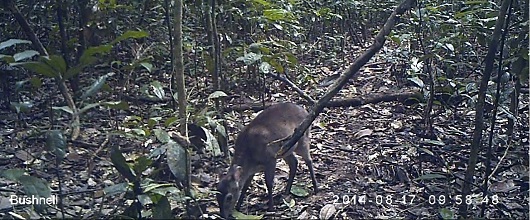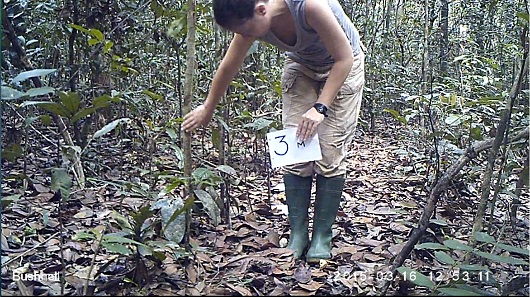Estimating animal populations from camera trap surveys

Camera traps are a useful means for researchers to observe the behaviour of animal populations in the wild or to assess biodiversity levels of remote locations such as tropical rain forests.
Researchers from the University of St Andrews, the Max Planck Institute for Evolutionary Anthropology (MPI-EVA) and the German Centre for Integrative Biodiversity Research (iDiv) recently extended distance sampling analytical methods to accommodate data from camera traps.
This new development allows abundances of multiple species to be estimated from camera trapping data collected over relatively short time intervals – information critical to effective wildlife management and conservation.
Remote motion-sensitive photography, or camera trapping, is revolutionising surveys of wild animal populations. Camera trapping is an efficient means of detecting rare species, conducting species inventories and biodiversity assessments, estimating site occupancy, and observing behaviour. If individual animals can be identified from the images obtained, camera trapping data can also be used to estimate animal density and population size.
For this reason, camera traps were initially popularized by researchers studying big cats and other species with distinctive coat markings. Since then, thousands of camera traps have been deployed in wildlife habitat across the globe, especially in tropical forest ecosystems where animals are difficult to survey by other means. However, methods for estimating abundances of species which cannot be individually identified are still in development, and none is generally accepted or broadly applied.

Professor Stephen Buckland from the Centre for Research into Ecological and Environmental Modelling (CREEM) at St Andrews said: “Many animal populations are difficult to monitor effectively, but technological advances are opening up new strategies. The challenge for the statistician is to keep pace with the technological advances, and ensure that models are available to exploit fully the resulting data. This work is an important step in that direction.”
Hjalmar Kühl of the MPI-EVA and the iDiv said: “This development will pave the way for researchers to estimate abundances of multiple species from camera trapping data collected over relatively short time intervals, without identifying individuals, and with minimal additional field work.
“This new approach can be easily integrated into our ongoing camera trap surveys across a broad range of habitats and species; we will also apply it in our monitoring work.”
Eric Howe from CREEM said: “Given the current rates of species extinction and loss of biodiversity, I’m excited to be involved in research that has the potential to provide improved information to wildlife and conservation managers in a timely fashion.”
Background information
Distance sampling with camera traps: Methods in Ecology and Evolution by Howe EJ, Buckland ST, Després-Einspenner M-L, Kühl HS; April 2017, DOI: 10.1111/2041-210X.12790
- Max Planck Institute for Evolutionary Anthropology (MPI-EVA)
- German Centre for Integrative Biodiversity Research (iDiv)
- Centre for Research into Ecological and Environmental Modelling (CREEM)
Image captions and credit
Credit: Max Planck Institute for Evolutionary Anthropology.
Caption: Still images captured from video recorded by a camera trap set in Tai National Park, Cote D’Ivoire
Issued by the University of St Andrews Communications Office, contactable on 01334 467310/2530 or [email protected].
Category Research